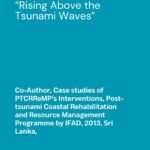
Value Based Land Partition Model: A case study in Homagama Pradeshiya Sabha Area
January 19, 2025
Rising Above the Tsunami Waves
January 19, 2025Abstract
Land and landed properties are fundamental ingredients for the socioeconomic development of a country. In any development project, land and buildings are essentially a part of it as either among its inputs or in the process or among the outputs of the project. On the other hand, land is an inevitable investment or/and consumption purchase of all individuals, families, organizations and nations. Hence, in a market economy, land and property market is supposed to play a live and a vibrant role instead to be a silent or unreliable sector. However, research on land and property markets in various context raises debatable questions over some concepts associated with land and property markets such as ” informality of markets ” , ” immaturity of markets ” , ” land as dead capital ” , property crimes ” , ” lack of property democracy ” , ” unaffordable land and property prices ” , ” lack of professional engagement ” etc. Even though there are several debatable problems in global land markets, it is clear that all such problems are interrelated and collectively influence the price formation resulting unprofessionally decided property prices in the market disrupting all the socioeconomic goals of such nations. Most of developing cities, including the city of Colombo, with poorly organized land and property markets have been facing this problem as a vicious cycle. Hence, the aim of this paper is to analyze the role of the property markets in general and issue in connections with the price formation of land and landed properties in Colombo in particular. This theoretical discussion is underpinned with some practical cases and life experience of authors. At the end, some recommendations are presented for a moderate situation against the problem.
Other Publications
A critical analysis of land tenure and property value
Authors: Download References Abstract This report refers to a valuation carried out in 2008 for a hotel located in the suburbs of Colombo intended for sale. […]Rising Above the Tsunami Waves
Authors: Information Rising Above the Tsunami Waves , Co-Author, Case studies of PTCRReMP’s Interventions, Post-tsunami Coastal Rehabilitation and Resource Management Programme by IFAD, 2013, Sri Lanka, […]Review of Price Formation of Land and Landed Properties in Colombo: Is it a Myth or Reality?
Authors: Download References Abstract Land and landed properties are fundamental ingredients for the socioeconomic development of a country. In any development project, land and buildings are […]


